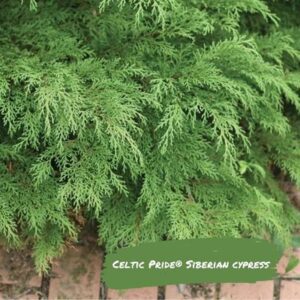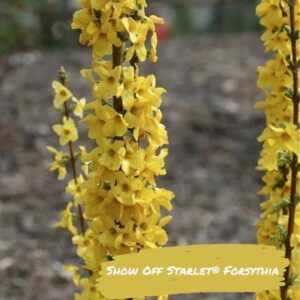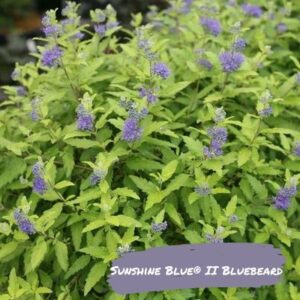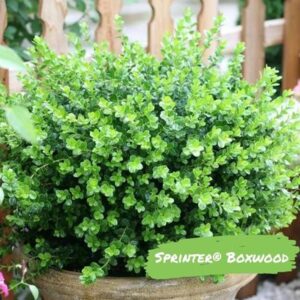It never fails. You plant a new flowering shrub. It’s one you’ve been wanting for a while now, and you dream of how it will look in a couple years, in that developing back border bed.
With great care you dig it in so as not to disturb the nearby mixed forbs and other perennials. And a day or two later – the shrub and nearby plants are picked over like the salad bar at the local restaurant.

Celtic Pride® Siberian Cypress – Height: 1 to 3 feet. Spread: 4 to 6 feet. Exposure: Part to Full Sun. USDA Hardiness Zones 2 to 7.
(All photos throughout this blog are courtesy of Proven Winners.)
Whitetails on the Rise
Most likely, and especially if you live in a rural area or a suburban municipality, you can thank the hungry North American whitetail deer. Experts say their population is 100 times greater today than it was about that many years ago. The current population is about 30 to 35 million (from 300,000 in 1930).
The whitetail is found in nearly every state of the country, except Alaska, California, Hawaii, Nevada and Utah. Texas leads the pack with an estimated 5.3 million.

Show Off Starlet® Forsythia – Height & Spread: 2 to 3 feet. Exposure: Part to Full Sun. USDA Hardiness Zones: 5 to 8.
Menu of Leafy Greens
Whitetail deer are North America’s most abundant large herbivore. From acorns to apples, their preferred foods read like a menu. Deer enjoy forbs including daylilies and milkweed. They like fall leaves, fir needles, shrubs, treetops and the leafy parts of woody plants.
Their daily nutritional requirement is to eat about 8% of their body weight in leafy greens. On average, a mature whitetail buck weighs between 160 and 210 pounds. You don’t need to be a math whiz to understand why your shrubs and leafy plants have teeth marks.

Sunshine Blue® II Bluebeard – Height & Spread: 2 to 3 feet. Exposure: Part to Full Sun. USDA Hardiness Zones: 5 to 9.
Plant Munching Impacts
Deer have adapted to not just coexist – but thrive – in our human habitats. These include, of course, the edges of roadways, especially in dark-of-night conditions when bright headlights and tapping the breaks is a must. They also live in our forest preserves, public gardens and parks, roadside meadows and – wouldn’t you know – our suburban backyards.
While living peacefully with these beautiful creatures is certainly the objective, more deer means more plant munching. That affects the health and viability of our gardens and landscapes. It reduces plant sources for beneficial pollinators and, ultimately, obstructs the vitality of the local ecosystem.

Sprinter® Boxwood – Height & Spread: 2 to 4 feet. Exposure: Shade to Part & Full Sun. USDA Hardiness Zones: 5 to 9.
Plants as Solutions
Fortunately, there is a solution and, at Loma Vista Nursery, we’re proud to help grow deer resistant plants, including for Proven Winners. The shrubs we’re including in this blog are varieties we grow from the Proven Winners’ Deer Proof Shrubs line.
These plants are expressly bred for deer resistance, which means deer are less likely to eat them due to a variety of factors including flavor, texture and smell. Deer will still try to nibble them if they’re hungry. That’s why they’re resistant plants. But fuzzy or prickly foliage, thorny stems, bitter taste or strong scent will encourage deer to move on their way.

Sunjoy Gold Pillar® Barberry – Height: 3 to 4 feet. Spread: 2 to 3 feet. Exposure: Full Sun. USDA Hardiness Zones: 4 to 8.
First Season Protection
So how were these plants selected for the Deer Proof Shrubs line? Proven Winners says the company’s staff of professional horticulturists poured over resources from university websites across North America, reviewed books and pulled from their own experience to compile a collection of plants that deer are unlikely to eat.
“Plants fresh from the grower or garden center are far more appealing to deer than plants that have been growing out in the landscape,” Proven Winners says on its website. “They have been pumped full of water and fertilizer, making their growth far softer and more succulent than growth that emerges naturally outdoors. As such, in areas with severe deer pressure, new plants should be protected with repellent, netting or fencing for their first season.”

Sunjoy Todo® Barberry – Height & Spread: 1½ to 2 feet. Exposure: Full Sun. USDA Hardiness Zones: 6 to 8.
Learn More About Loma Vista Nursery’s Landscape Plants
Loma Vista Nursery expertly grows a variety of deer resistant perennials, trees and shrubs for Midwest independent garden centers, landscape contractors and wholesale distributors. If you have questions about the shrubs pictured here or any other deer resistant plants we grow, please reach out.
Our staff members are experts in the field who love helping people learn and understand more about the healthy plants we grow. To get help with your orders and answers to plant-related questions, send an email to sales@lomavistanursery.com or call (785) 229-7200.
You can also visit our plant catalog for more information and review our website to learn about our values and best-practices as a Midwest plant grower.
Connect with Us
Stay current on our plant recommendations, species highlights, growing tips and more by following us on social media.
